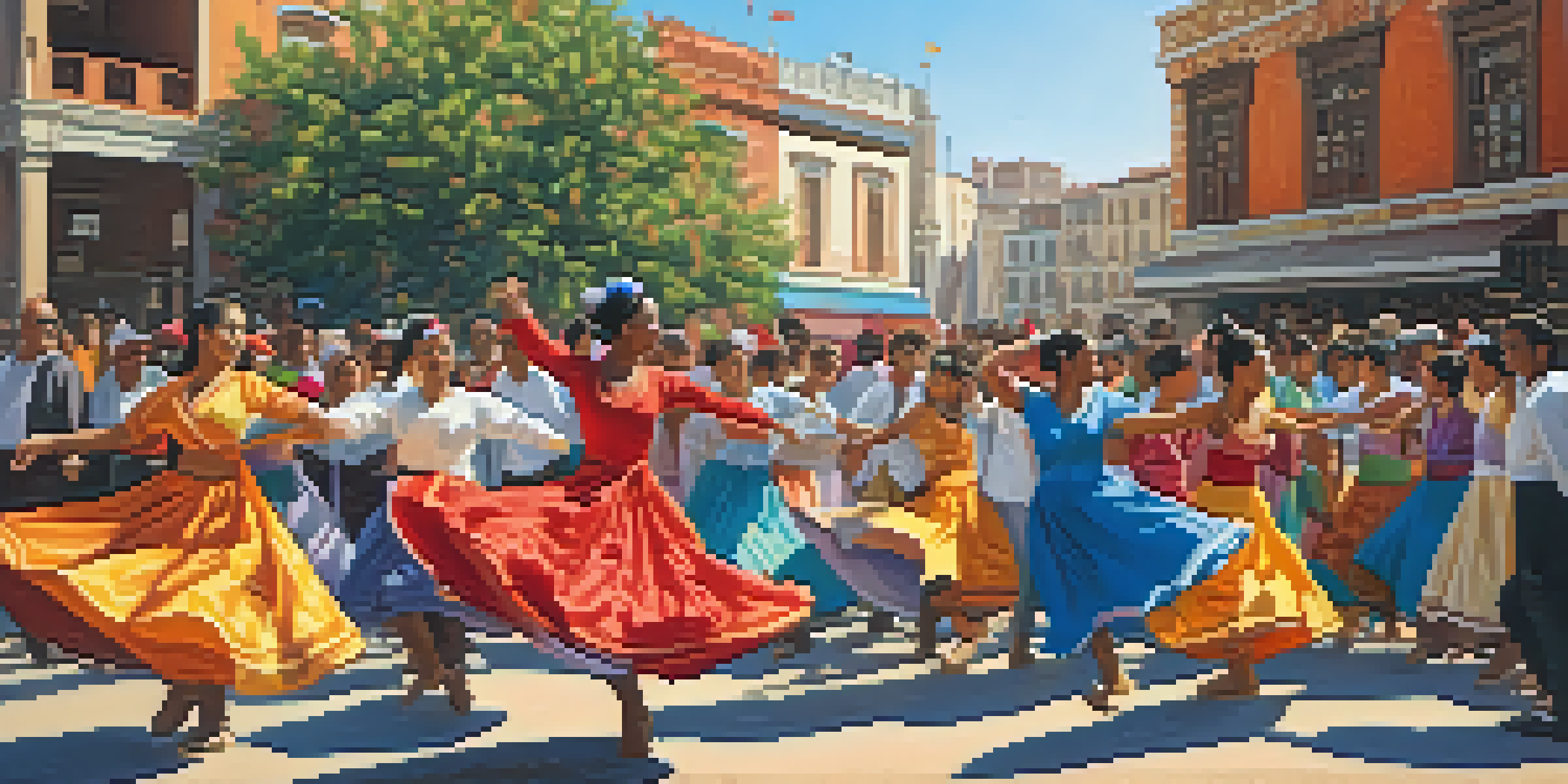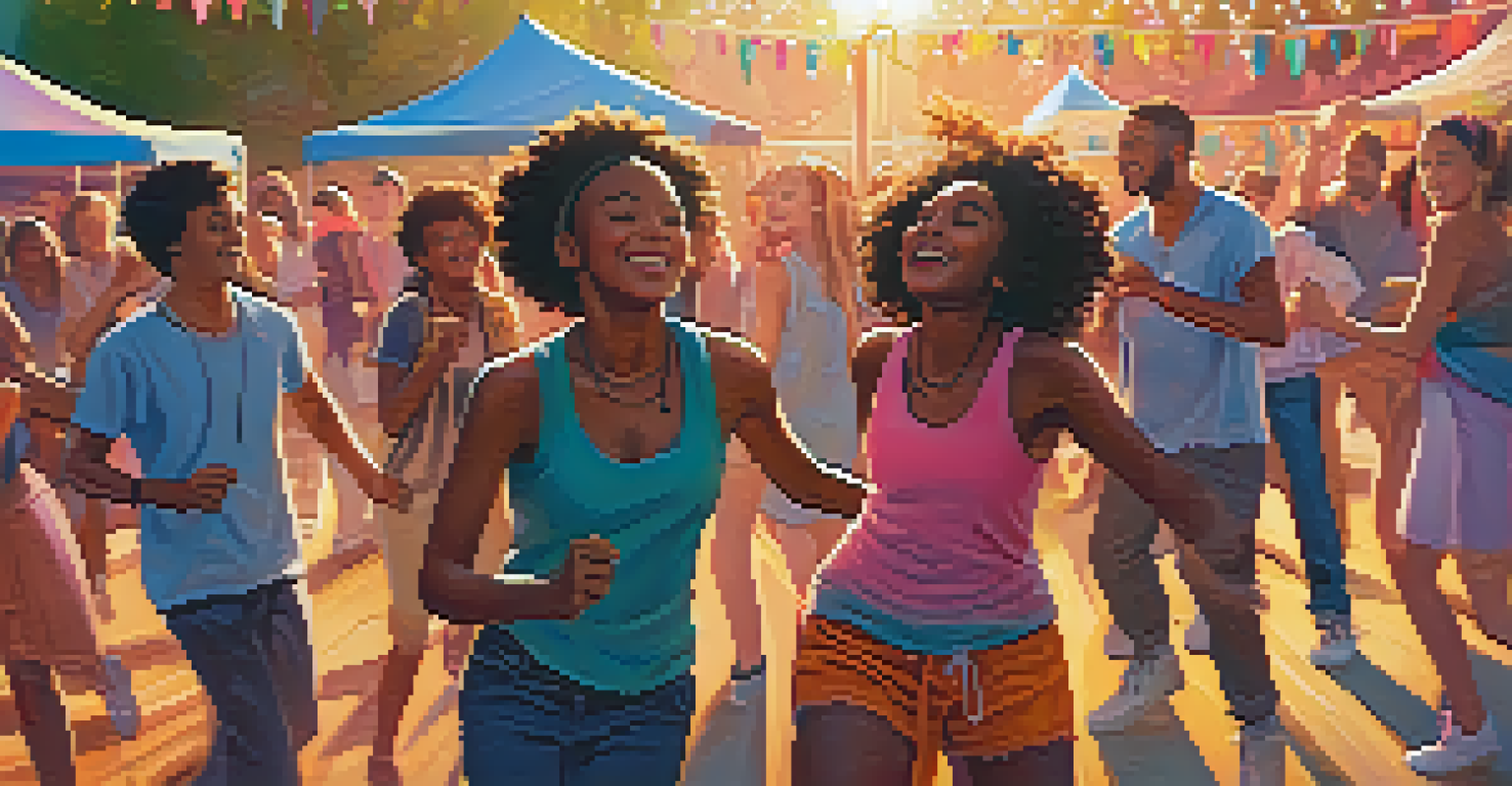Exploring Dance as a Symbol of Rebellion in Literature

The Power of Dance: A Universal Language of Rebellion
Dance has long been a form of expression that transcends words, often embodying emotions and sentiments that are difficult to articulate. In literature, it serves as a potent symbol of rebellion, allowing characters to defy societal norms. Through the act of dancing, individuals can reclaim their autonomy and express dissent, making it a powerful metaphor for resistance.
Dance is the hidden language of the soul.
For instance, in some literary works, characters engage in dance to escape oppressive environments or to challenge authority. This act can be seen as a way to break free from the constraints that society imposes on them. The rhythm of their movements often mirrors the heartbeat of their struggle, making the act itself a form of protest.
Moreover, dance in literature can unify characters against a common adversary. It fosters community and solidarity, illustrating how collective movements can amplify the message of rebellion. By coming together to dance, characters not only assert their individuality but also build a collective identity that challenges the status quo.
Historical Context: Dance as Protest in Literature
Throughout history, dance has been intertwined with social and political movements. In literature, this connection often reflects real-world events, where dance emerges as a symbol of defiance against oppressive regimes. Authors use dance to comment on historical injustices, providing readers with a deeper understanding of the time period.

For example, in works set during the Civil Rights Movement, dance represents both celebration and protest. It serves as a reminder of the struggles faced by marginalized communities while also highlighting their resilience. Through the act of dancing, characters in these stories reclaim their identities and assert their rights.
Dance as a Symbol of Rebellion
In literature, dance serves as a powerful metaphor for both societal and personal rebellion, allowing characters to express dissent and reclaim their identities.
This historical context enriches the narrative, allowing readers to see how dance has been a vital part of cultural resistance. By weaving historical references into their storytelling, authors not only educate readers but also inspire them to reflect on the ongoing relevance of rebellion in their own lives.
Dance in Classic Literature: A Symbol of Rebellion
Classic literature often features dance as a key element in illustrating rebellion against societal expectations. In works like 'Pride and Prejudice' by Jane Austen, dance scenes reflect characters' desires to break free from rigid social hierarchies. These moments of joy and spontaneity contrast sharply with the constraints placed upon them by society.
The dance is a poem of which each movement is a word.
Similarly, in Shakespeare's plays, dance is frequently employed to depict rebellion against authority. In 'Romeo and Juliet', the masquerade ball serves as a backdrop for the forbidden love between the two protagonists. Their dance symbolizes their defiance against their feuding families, highlighting the theme of individual desire clashing with societal norms.
Through these literary examples, we see how dance acts as a catalyst for change, allowing characters to challenge the roles assigned to them. It creates moments where characters can express their true selves, revealing the complexities of human emotions in the face of societal pressures.
Modern Literature: Dance as a Rebellion Against Conformity
In contemporary literature, dance continues to serve as a potent symbol of rebellion, particularly against conformity. Authors often depict characters who use dance to break away from societal expectations, illustrating a desire for authenticity. This theme resonates strongly with today's readers, who may feel the pressures of fitting into predefined molds.
For instance, in works like 'The Perks of Being a Wallflower', dance becomes a means for characters to express their individuality. The act of dancing in a carefree environment allows them to feel liberated from their struggles and societal norms. This rebellion through dance not only speaks to the characters' personal journeys but also resonates with readers on a broader level.
Historical Context of Dance
Throughout history, dance has been intertwined with social movements, reflecting real-world struggles and serving as a symbol of defiance against oppressive regimes.
Moreover, modern narratives often explore the transformative power of dance, showcasing how it can lead to self-discovery and empowerment. By embracing their passions, characters challenge the expectations placed upon them, ultimately forging their own paths. Dance thus becomes a metaphor for personal rebellion in the face of societal constraints.
Cross-Cultural Perspectives: Dance as a Global Symbol of Rebellion
Dance's role as a symbol of rebellion is not confined to any single culture; it spans across the globe. Different societies use dance to express resistance against oppression, making it a universal language of dissent. In literature, authors often draw from these diverse cultural practices to enrich their narratives.
For example, various African and Indigenous literatures incorporate traditional dances to signify resistance against colonialism. These dances tell stories of struggle and resilience, reinforcing community bonds while challenging external forces. By weaving these cultural elements into their works, authors highlight the importance of heritage and collective memory in the fight for justice.
Furthermore, exploring dance through a cross-cultural lens allows readers to appreciate the shared human experience of rebellion. It fosters empathy and understanding, bridging gaps between different societies. As readers engage with these narratives, they are invited to reflect on their own cultural practices and the role of dance in their histories.
Dance as a Personal Rebellion: Individual Stories in Literature
Beyond societal rebellion, dance in literature often illustrates personal struggles. Many characters use dance as a way to confront their inner demons and reclaim their identities. This personal rebellion is just as impactful, showcasing the transformative power of self-expression through movement.
In novels like 'The Fault in Our Stars', characters find solace in dance, using it as a means to cope with their challenges. Their moments of freedom through dance represent a rejection of their circumstances, allowing them to embrace life in the face of adversity. This personal journey resonates with readers who may also seek liberation from their own struggles.
Cross-Cultural Dance Narratives
Dance transcends cultural boundaries, showcasing a universal language of resistance that resonates with diverse communities facing oppression.
Ultimately, personal rebellion through dance highlights the importance of self-acceptance and individuality. It encourages readers to reflect on their own experiences and the ways in which they can embrace their uniqueness, inspiring them to dance to the rhythm of their own lives.
Conclusion: The Lasting Impact of Dance as Rebellion in Literature
In conclusion, dance serves as a powerful symbol of rebellion in literature, encompassing both societal and personal struggles. Through the act of dancing, characters assert their individuality, challenge authority, and inspire change. This theme resonates across genres and cultures, reflecting the universal desire for freedom and self-expression.
As readers engage with these stories, they are reminded of the transformative power of dance and its ability to unite individuals in their quest for authenticity. Whether in classic literature or contemporary narratives, the dance of rebellion continues to inspire and resonate with audiences.

Ultimately, exploring dance as a symbol of rebellion invites us to reflect on our own lives and the ways we can challenge societal norms. It encourages us to find our own rhythm, embrace our identities, and dance to the beat of our own drum, no matter the obstacles we face.